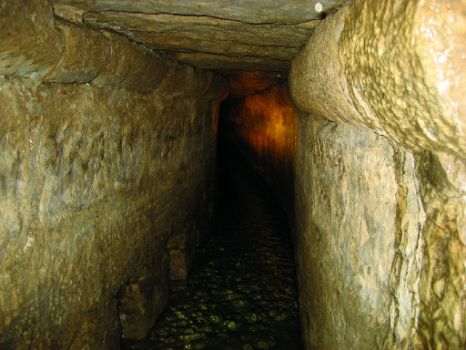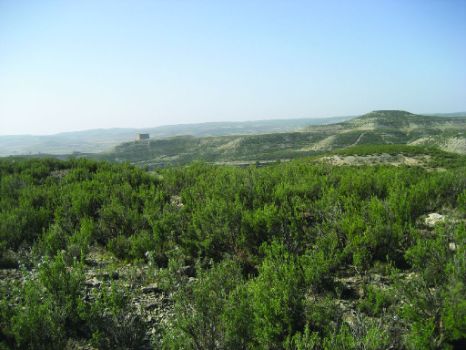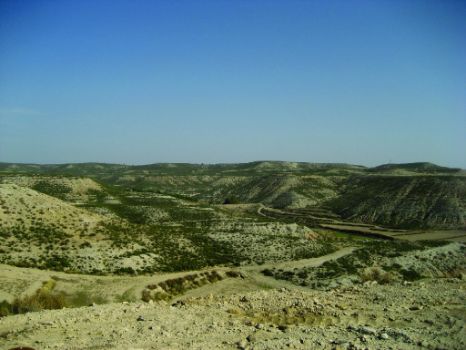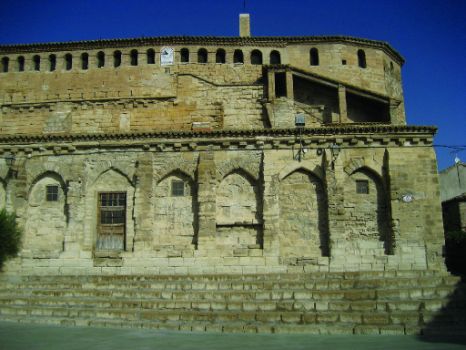Net of Natural
Trails

Castejón de Monegros Nature Trail
Description
Underground aqueducts protected by the sierra
This Trail, which runs through the vicinity of the town from which it takes its name, crosses a landscape that is dominated by the nearby Sierra de Alcubierre, where the patient work of all its old inhabitants, who were determined to cultivate this arid land albeit a formidable task, is still alive today.
EThe route begins in the town, at a fountain known as “Fuente de Arriba”, which is supplied by water from the nearby “Fuente Madre” or Mother Fountain. This is the only point on the Trail where you can fill up with water, which is located next to the information panel that details the key characteristics of the route.
If you leave from this point, you will be able to follow several routes offered by the Trail. The first, which is circular in nature, provides access to the castle of Castejón de Monegros, and after continuing to border the location of La Cordera, it returns, on its last leg, to the Chapel of Santa Ana. The second itinerary leads directly to the Fuente Madre.
1 - Circular route:

Leaving from the “Fuente de Arriba”, this pathway heads through the streets of the town towards the castle, a Gothic-style building that dates from the early 13th century, which is located on a hill to the north of the city centre. The Chapel of San Sebastián and San Fabián can be found among its remains, next to a resting area that offers an excellent view of the area.
The route continues by bordering the location of La Cordera. Thanks to the elevation of this leg of the Trail, there are different viewpoints, such as that of San Fabián, overlooking the spectacular landscape of Los Monegros, which is covered in junipers (Juniperus sp.), thyme (Thymus sp.) and rosemary (Rosmarinus officinalis), species that are able to withstand the high temperatures of the area and the gypsum-rich ground. The route continues across hills, plains and ravines until its descent begins when it reaches the viewpoint of San Sebastián; a privileged promontory where the trail user can see the town and castle of Castejón and the Chapel of Santa Ana, made to look tiny in comparison with the vastness of the region.
The route turns back into the town again, passing on one side the municipal sports centre and the school, to then continue in a southerly direction, crossing the HU-831 highway, and following a shady pathway towards the Chapel of Santa Ana, the patron saint of the town, located at the end of a promontory where it overlooks the whole town and where every year a pilgrimage is staged in her honour.
From the chapel, the Trail continues across an area whose use is shared with motor vehicles and is marked off by wooden logs, until it returns to its starting point at the “Fuente de Arriba”.
2 - Route to La Fuente Madre:

A pathway for the exclusive use of pedestrians and cyclists leaves “La Fuente de Arriba” to head, among farmlands, to La Fuente Madre, an underground aqueduct that supplied the town of Castejón with water. You can visit its interior and there is also a resting area in the vicinity.
Sites of interest
Profile

Highlights
Further information
La Fuente Madre
“La Madre” is an underground aqueduct whose era and construction are unknown, although its origins are alleged to date back to the period of Arab colonisation. It is situated in the centre of three valleys with a layout that begins in the hollow of La Val del Carro, a rather arid spot.
From the inside of a recently-built hut, you can access this channel, whose mission for centuries has been to collect and transport water from a spring located two kilometres away to the fountain of Castejón de Monegros.
It is in good condition since the stony building material, the architectural system largely made of dressed stone and its use and maintenance by the inhabitants have enabled it to be so for generations. At the present time, the fountain remains and its waters are still used, but mainly for farming purposes.






